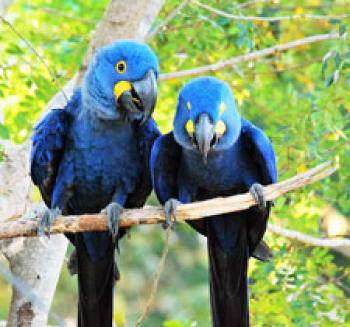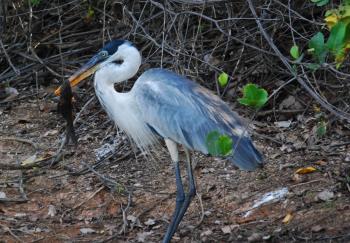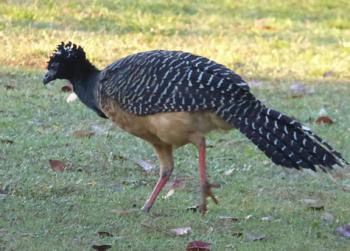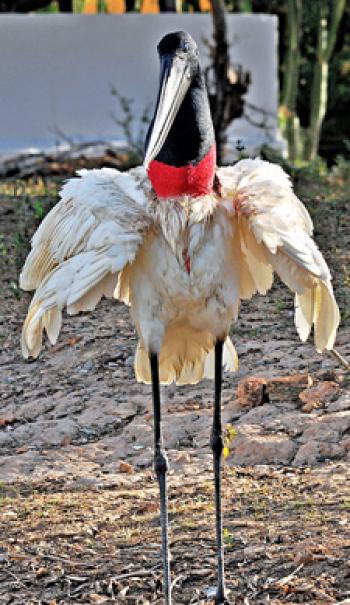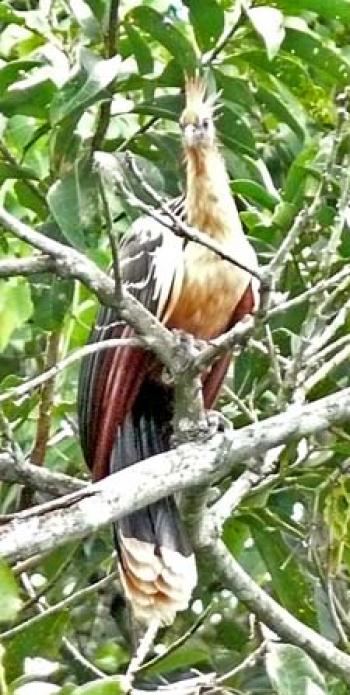A good bird-watching site (Part 3)
Subscribers were invited to write in about places, outside of the US, where they’ve had rewarding sightings of birds. (We cannot accept more submissions.)
In addition to the types of birds they saw, we asked travelers to each tell us where they were and the year/month/time their visit took place. We also wanted to know how difficult it was to reach an area, what equipment would be recommended and what the weather was like.
The most responses were about birds in Latin America, and we’re printing the last of those this month, with letters about other areas to follow.
My husband, Knox, and I traveled to BRAZIL in July and August of 2012 to study wildlife, with an emphasis on birds. Because Brazil is a very large country, we concentrated on only two areas: the Pantanal of the Central-West Region and also a UNESCO reserve in the Atlantic rainforest, northeast of Rio de Janeiro.
•
The Pantanal is the world’s largest tropical wetland, spilling over into Bolivia and Paraguay. UNESCO declared it a World Heritage Site in 2000.
We had been several times to the Amazon, and, while we heard bird chatter, we saw relatively few species from the river, as the forest cover was so thick. However, the Pantanal is full of seasonal pools and crossed by several rivers, including the Rio Negro and Rio Cuiabá, which allow close-up views of huge varieties of birds and mammals.
We flew into the city of Cuiabá, then drove to Poconé at the northern entrance to the Pantanal, where we began our drive on the entire length of the Transpantaneira road. The area dries out in July, and then one can drive the 90 miles — and over about 120 wooden bridges — from Poconé south to Porto Jofre, where the road ends.
Each morning, while staying at Pouso Alegre Lodge (Transpantaneira Road KM33, Poconé, MT, Brazil; www.pousalegre.com.br), we were awakened by the raucous choir of large, roosting chaco chacalacas, the local alarm clocks that noisily greet the dawn and announce bedtime as well.
Hyacinth macaws, special inhabitants of the Pantanal, are a near-endangered parrot species, with only about 6,500 left in the wild. Generally found in pairs, we saw them on the Pouso Alegre grounds and also at Porto Jofre. The largest of the macaws, these spectacular blue birds can grow up to 40 inches long.
We hired a driver/guide, Isiel, via Eduardo Falcao of Jaguar Ecological Reserve (phone +55 65 2136 2410, www.jaguarreserve.com). Isiel’s English was very good.
He drove a large, 4-wheel-drive vehicle and was equipped with 5-gallon jerry cans of water plus emergency supplies, extra gas, night-safari floodlights, a bird app on his phone, books and a great deal of knowledge about the area we were to explore for the next 10 days.
We went on several dirt-road safaris with Isiel. These were most productive early in the morning and late in the afternoon, as midday was quite hot.
Some birds inhabited the dry Cerrado, including the red-legged seriema, rhea, chaco chacalaca and curassow plus various raptors. However, most birds were found in or near the water.
In the dry season, large wading birds can easily be seen from the road, often in groups of mixed species, even alongside the ever-present caimans. Observation and photography of these birds is especially rewarding because of their large size and the fact that they are relatively slow-moving. In addition, they often are habituated to the traffic on the road.
The most impressive of all is the jabiru, the symbol of the Pantanal. It may grow up to 4½ feet tall, with a wingspan of 9 feet, and can weigh as much as 20 pounds. A nesting pair of jabirus will build a huge, messy, 3-foot-wide nest atop a large tree.
There are numerous species of herons in the Pantanal. The largest, the cocoi at 4 feet tall, is a solitary bird that nests in trees. Among other large birds are the red-footed wood stork, roseate spoonbill and anhinga.
Midsize birds there that are easily seen and photographed include the wattled jacana, green ibis, gray-necked wood rail, chestnut-eared aracari and green-billed toucan.
Smaller birds we saw included the monk parakeet, plush-crested jay and greater and lesser kiskadees and, my favorite small bird, the guira cuckoo, which is the punk rocker of the bird world, as it looks like it has been dragged through a hedge backward.
Besides the road safaris, we took numerous river safaris, some of which were on the Rio Claro, which runs along the property of the Pousada Rio Claro (Transpantaneira KM 41, Poconé 78175-000, MT, Brazil; phone +65 3345 2449, pousadarioclaro.com.br), in the middle of the Pantanal.
This farm has developed into a popular lodging and restaurant site, where locals stay for a few days to enjoy the food and the swimming pool. The adjacent land was carefully tended to offer safe haven to wildlife, so we could take the camera just outside our room and find everything from a caracara to a curassow strolling the grounds.
At the pousada, private boat trips were available every day. Birding on these trips proved very rewarding, as the boats did not seem to disturb the wildlife. We often saw large-billed terns, Amazon kingfishers and ringed kingfishers. The only drawback was the presence of mosquitoes. On one occasion, the cloud of little vampires was particularly large and aggressive and we had to turn back.
•
The second of our birding sites in Brazil, only a 2-hour drive from Rio de Janeiro, was the Atlantic Rainforest, where there are at least 118 endemic bird species to be found. One of the rarest is the three-toed jacamar, which, with luck, can be spotted on an excursion into Três Picos State Park.
We were picked up at our hotel by a driver from Serra dos Tucanos Birding Tours (serradostucanos.com.br), owned and operated by Andy and Cristina Foster. Various excursions were offered, and we took the three-toed jacamar one.
At one stop, I remained in the van because the very bird we had hoped to see, a jacamar, was perched on a branch right outside the van window. The much-coveted bird, which somewhat resembles a hummingbird, is very, very small, nondescript, shy and scarce. Due to habitat loss, there may be as few as 350 individuals left.
It is sometimes difficult to decide on how much equipment is enough to take decent photos and how much is just too much to carry. Knox and I took two cameras: a small street camera, a Canon PowerShot, and a Nikon D80 with several lenses, the longest being a Sigma 120-400mm. I took a monopod as well.
These choices proved to be good ones. Our photos in the Pantanal were frequently taken with the larger camera resting on the truck window during a pause, as we were often on the move.
We also took the following book written on Pantanal birds: “A Photographic Guide to Birds of Southern Brazil” by Clive Byers [currently out of print]. Our guide had additional bird books available.
If you go, take a hat, sunscreen and bug repellent! Wet wipes are a good idea too, as the roads can be very dusty and, if your vehicle does not have air-conditioning, the windows will be wide open.
Do go to Brazil for the birds. You will not be disappointed.
Diane A. Bell
San Diego, CA
Most of my traveling is geared toward bird and wildlife observation. One of the best destinations I have traveled to is Esteros del Iberá in Corrientes province, ARGENTINA. I visited the region in January of both 2005 and 2017.
This provincial reserve is southeast of the city of Corrientes. In 2017, I bused to the town of Mercedes and then, through a local travel agency, arranged for a private driver to take me 70 miles northeast to the village of Carlos Pellegrini, where there were several accommodation options, one of which I also booked through the agency.
The first 20 miles from Mercedes were paved; the remaining miles were sandy gravel. Although the road was passable by a sedan, rains would make it challenging; a 4-wheel-drive vehicle is recommended.
I stayed at a hotel on the eastern shore of Lago Iberá and near the campground from which launches departed. Using Carlos Pellegrini as my base, I made excursions into the Iberá wetlands and surrounding savannah.
Hiring a launch in the morning or afternoon, I would cruise the marshy shoreline of the wetlands, observing a variety of herons, cormorants, jacanas, kingfishers and aquatic birds. The weather was subtropical. During early to mid-January, thunderstorms frequently occur.
The hotel manager arranged for me to go on the launch tours, each of which lasted about two hours. A morning tour group I joined had four other visitors and the guide and cost me $50. A guided solo tour in the afternoon cost $100-plus.
Hiking through grassland or woodland, I observed numerous passerine bird species, the most abundant being the rufous hornero, great kiskadee and fork-tailed flycatcher. Approximately 330 avian species have been recorded there, of which I observed about 100 over eight days.
A variety of nonavian species also can be observed. Black caimans cruise the lake. Capybaras (pig-sized rodents) and marsh deer graze in the marshland.
My most rewarding experience occurred in 2005 when I interacted with a wild Geoffrey’s cat that had momentarily settled near the park headquarters.
Harry Conwell, Jr.
Topeka, KS
While on an Amazon trip in PERU in October 2009, my husband and I saw the horned screamer several times. This is a fairly big bird, about the size of a pheasant, and it lets out screams heard all over the river.
In the Pacaya-Samiria National Reserve, we also were fortunate to find a small flock of hoatzins, up in a tree overlooking the water. The hoatzin looks like a prehistoric bird. In 2013 we returned to the Peruvian Amazon in late May, early June, when it was quite dry, and we did not see any hoatzins.
I was told that the high-water level, as we experienced in October, drives the animals and birds up into smaller land areas, making them easier to find. Still, the hoatzins, I believe, were simply a lucky sighting.
Anne Warburton
Yorba Linda, CA
Next month, birds in Africa.

